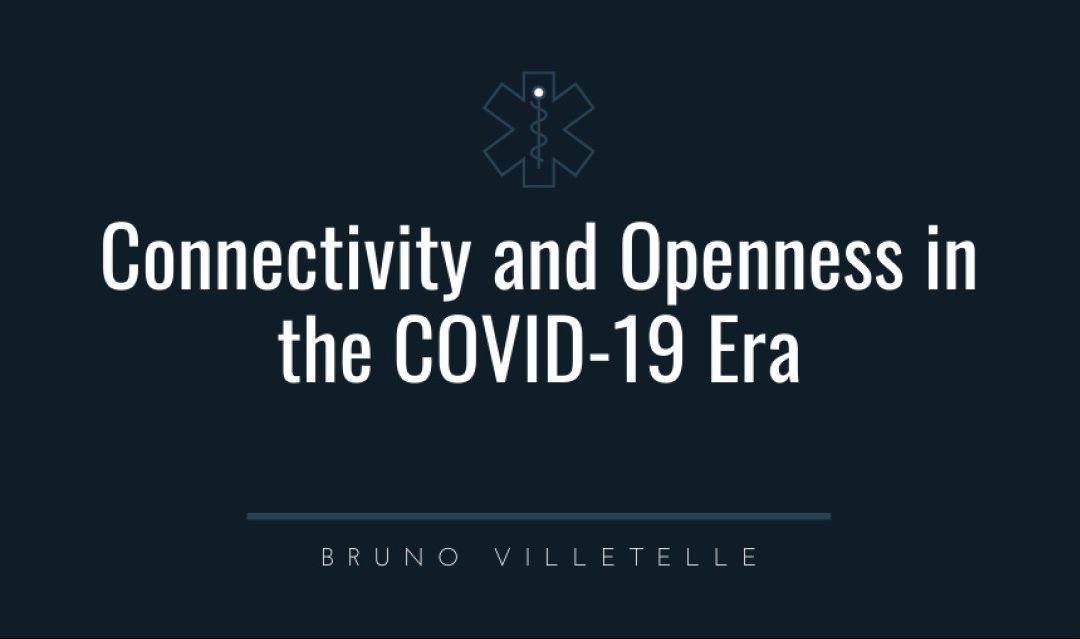
Connectivity and Openness in the COVID-19 Era
This article was originally published on Bruno’s LinkedIn.
Many journalists and bloggers use “unprecedented” to describe our current situation. No word is more appropriate. Communities around the world are engaging in an epic struggle to mitigate the spread and impacts of COVID-19. We are indebted beyond reconciliation to healthcare professionals and caregivers working on the front-lines of the pandemic. There is much to learn from the COVID-19 outbreak. In particular, two lessons cannot escape attention: 1) Embracing data science and digital technology is no longer optional for our healthcare systems, and 2) Open collaboration and innovation are essential to #reimaginingmedicine.
Collaboration Between Life Science Companies
It is clear that COVID-19 is not a sequestered issue—it is a global pandemic that has traveled far and wide to impact some of our world’s most vulnerable populations. For this reason, the collaborative efforts of life science companies as they work to minimize and mitigate the overall impact of the novel coronavirus was much needed and unheard-of. The Bill and Melinda Gates Foundation’s efforts to pool resources across 15 life science companies is especially notable. This group will share their libraries of resources, which include unique molecular compounds that could potentially turn the tides in the public health sector’s favor. Those molecular libraries have found a home in the COVID-19 Therapeutics Accelerator, a platform developed by the Gates Foundation. Researchers use this tech to quickly identify which compounds and options are most likely to make a positive impact. Combined with accelerated vaccine and therapeutic trials and the combination of data from a multitude of countries and sources, the initiative has the potential to create a step-change on both national and international levels.
Collaboration Between Healthcare Providers and Tech Companies
Stay-at-home and quarantine orders are limiting people’s access to healthcare around the world. For some people,healthcare providers are able to visit them at their home, but this is not an option for most. Where home delivery is not possible, even access to medication is disrupted. Technologies such as home assistants and telemedicine are enabling healthcare providers to reach their most vulnerable patients without making direct, person-to-person contact. Hospitals are using AI combined with sensors for a variety of tasks, from tracking patient temperatures to detecting acute respiratory conditions. These technologies allow patient monitoring without putting healthcare providers at more risk for infection. Providers have utilized drones to reach those who cannot leave their homes whether due to compromised immune systems or mild symptoms and to drop off medical supplies from rural locales in Ghana to cities across the United States. Their service include prescription drugs, medical implements such as swabs and masks, and even COVID-19 testing kits. Organizations, including the World Health Organization, IBM, Oracle, Microsoft, and other tech companies, government agencies, and international health organizations are partnering in building the blockchain-based open data hub called MiPasa. It is poised to enable rapid and precise detection of COVID-19 carriers and infection hotspots around the world.
Health Authorities’ Overall Collaborative Position
As the crisis has played out, health authorities have seen the fruit of their digitalization efforts and are doubling down on these technologies – publishing and advocating positions that favor even further acceleration. The CDC, FDA and WHO, have recognized that digital health technologies can provide powerful tools for public health officials and the public in the management of the COVID-19 response. Germany, Switzerland and many more countries launched a dedicated hackathon in response to COVID-19. The Health Innovation Hub, established by Germany’s Ministry of Health, published a list of trusted telemedicine services. The Mayo Clinic and the Minnesota state health department developed an artificial intelligence-powered tool to determine which areas of the state were most at risk for spreading and contracting COVID-19. The National Institutes of Health’s Accelerating COVID-19 Therapeutic Interventions and Vaccines initiative launched in an unprecedented effort to bring together health agencies and members of the pharmaceutical industry in response to the current and future pandemics.
Connectivity and Openness, the “New Normal”?
As we begin to re-open businesses and schools, we should remember the value of collaboration within the healthcare ecosystem. Resource pooling, information accessibility, and new technologies played an important role in combating COVID-19. As usual, hindsight is “20/20” – it is hard to fathom what prevented us from unleashing this level of collaboration earlier. When we needed to stay physically apart, we saw the urgency to come together to combine our knowledge, skillsets and experience as illustrated above, but also in so many other examples.
These unprecedented times unearthed the need to move beyond the usual calls for open innovation: a need for connectedness, maybe deriving from Joy’s law, “no matter who you are, most of the smartest people work for someone else”. The state of urgency side-showed the prime focus on internal excellence, intellectual property protection and competitive vying and brought together people in totally new ways. I can not help asking, “what if” this connected openness, this #unbossed can-do mindset, were to become the real “new normal”?
